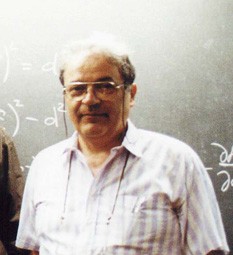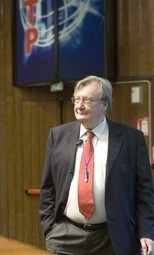Personal tools
News from ICTP 115 - Dateline

Nobel Prize in Physics 2005
The Royal Swedish Academy of Sciences has awarded the Nobel Prize
in Physics 2005 to Roy J. Glauber, Harvard University,
Cambridge, MA, USA; John L. Hall, University of Colorado, Boulder,
CO, USA; and Theodor W. Hänsch, Max-Planck-Institut für
Quantenoptik, Garching, Germany. Glauber lectured at the Adriatico
Conference on Vacuum in Non-Relativistic Matter-Radiation Systems
in 1987. In the 1970s, he collaborated extensively with Luciano
Bertocchi (former deputy and acting director of ICTP), Daniele
Treleani and the late Giorgio Alberi, all physics professors at
the University of Trieste.
Carlo Rubbia, Nobel Laureate in Physics, 1984, and former
director general of CERN, Geneva, Switzerland, delivered a special
lecture, "Does Nuclear Energy Have a Future?", on 17
October in the Main Lecture Hall. Rubbia received the Nobel Prize
for confirming the unification of nature's electromagnetic forces,
a theory for which ICTP's founding director, Abdus Salam, shared
the Nobel Prize in physics in 1979 with Sheldon Glashow and Steven
Weinberg.
ICTP Prize 2005
Xiaohua Zhu, professor at the School of Mathematical Sciences, Peking University, Beijing, China, has won the 2005 ICTP Prize. Xiaohua Zhu is being honoured for his fundamental contributions to complex differential geometry. At 37, Zhu is one of the world's foremost young geometers. The ICTP Prize carries a cash award of US$3,000, a medal and a certificate. The 2005 Prize is named in honour of the late Armand Borel, long-time professor at the Institute for Advanced Study at Princeton who has lectured at ICTP. The award ceremony will take place in April.
First Trieste Science Prize

T.V. Ramakrishnan (right)
The official ceremony for the first Trieste Science Prize took
place at Teatro Giuseppe Verdi in Trieste on 11 October.
T.V. Ramakrishnan, former member of the ICTP Scientific
Council and DAE Homi Bhabha professor of physics, Banaras Hindu
University in Varanasi, India, and Sergio Henrique Ferreira, professor
of pharmacology in the Faculty of Medicine at the University of
São Paulo in Ribeirão Preto, Brazil, were honoured
for their distinguished contributions to science-Ramakrishnan
for his fundamental theoretical contributions to our understanding
of how liquids turn into solids and Ferreira for research that
has paved the way for the development of a new class of highly
effective drugs to combat high blood pressure and ease inflammatory
pain. The Trieste Science Prize, which is sponsored by Illycaffè
and TWAS (The Academy of Sciences for the Developing World), in
collaboration with the Municipality of Trieste, carries a US$50,000
cash award.
Shukla and Tosatti Honoured

Padma Kant Shukla, Ruhr-Universität Bochum, Germany, has been awarded the American Physical Society's (APS) Nicholson Medal for Human Outreach. The medal is awarded annually "to recognise the humanitarian aspect of physics and physicists." Shukla, a world-renowned expert in theoretical plasma physics, has participated in ICTP training activities in plasma physics for more than two decades, serving as a course director since 1995. Specifically, APS honoured Shukla "for his prodigious and successful efforts in encouraging young scientists from under-represented countries throughout the world." The medal was presented at the APS's Plasma Physics Meeting in Denver, CO, USA, in October.

Former ICTP acting director Erio Tosatti has been awarded
the American Institute of Physics Tate Medal for International
Leadership in Physics. The award is being given for Tosatti's
"leadership and tireless effort in helping scientists from
developing countries to bring research in their home institutions
to world standards." Previous winners include ICTP founding
director Abdus Salam and former ICTP Scientific Council member
Roald Sagdeev.
Physics and Sustainable Development
ICTP director K.R. Sreenivasan published a wide-ranging article in the October 2005 issue of Physics World on the relationship between physics and sustainable development, focussing specifically on the challenges and opportunities faced by the developing world. The article appeared on the eve of the concluding event of the World Year of Physics---an international conference titled "Physics and Sustainable Development", which took place in Durban, South Africa, in autumn 2005 (see "World Year of Physics Looks to Future," pp. 6-7).
The Science of Culture
ICTP held a two-day workshop on Research Infrastructures and Cultural Heritage, RICH, on 12-13 December. The workshop---organised by several European scientific institutions, including Laserlab Europe, the Council for the Central Laboratory of the Research Councils (CCLRC), UK, and the Nuclear Technology Laboratory for Cultural Heritage (LABEC) in Florence, Italy---examined ways to bridge the knowledge gap between scientific research and cultural heritage. Specifically, participants discussed how laser, neutron, and synchrotron radiation techniques could aid efforts to investigate and conserve objects of historical and cultural significance. Special attention was paid to the role that such techniques can play in providing information for protecting and restoring heritage sites damaged by human and natural disasters and in curbing illegal trade in counterfeit art.
